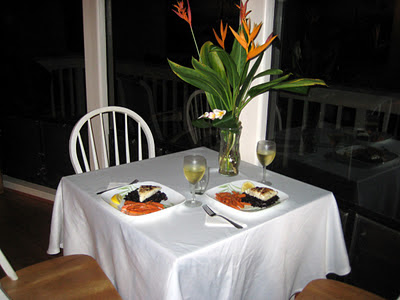Fish and I have a long and complicated history. Long ago, when I was young...last weekend, to be precise...I would have summarized our relationship as follows: (1) Raw fish is wonderful (except sea urchin "roe," which I vote we put in a separate category devoted to parts of animals I'd rather not think about). (2) Cooked fish is meh (technical culinary term; exceptions include salmon when we cook it or when ordered at
Alouette; trout when my mom cooks it; unagi in good sushi restaurants). (3) Shellfish get more complicated and are not included in this summary in the interest of reader sanity.
As of last weekend, however, my carefully ordered fish worldview has been shattered, and it's just the latest in a long list of overturned culinary preconceptions. Could it be that my once extensive and carefully cataloged collection of disliked foods were all over-generalizations? That it's just a matter of finding the right way to cook something?
In any event, I now love halibut. LOVE halibut. At least when it's made like this (loosely adapted from
here).
Serve this with a black
Forbidden rice pilaf (Heat a little olive oil in a pot over medium heat. Add a shallot, chopped, and saute until soft, then add the rice and stir to coat the grains. Stir in 1 1/4 cups
vegetable broth and bring to a boil. Turn the heat down to low and simmer gently for 20-25 minutes, or until the liquid is absorbed and the rice is tender).
Ingredients
2 halibut fillets
1/4 cup chickpea flour
1/4 cup
stone ground whole wheat flour
Kosher salt
Freshly ground black pepper
Ñora pepper (optional)
Olive oil
2/3 to 1 strip Niman Ranch applewood smoked bacon, sliced crosswise into strips
1/2 cup white wine
Juice of a little over half a Meyer lemon
1-2 tsp sliced
castelvetrano olives (cured with salt rather than pickled, and therefore an olive even an olive-hater can love...available at Whole Foods and the Sacramento Co-op)
2 tbsp chopped flat leaf parsley
2 tbsp pastured butter
About ten minutes before you need it, take the fish out of the fridge so that it's cool rather than cold when you start to cook it. Mix together the flours, 1/2 tsp salt, and peppers to taste in a shallow bowl. Coat the fish on all sides with the flour mixture just before you start cooking.
Heat a nonstick pan over medium heat. When hot, add the bacon and cook, stirring occasionally, until the pieces start to turn golden brown along the edges, lowering the heat a little if needed. Remove with a slotted spoon and let dry on a paper towel. Pour out most, but not all, of the bacon grease, and return the pan to the flame.
Add a couple tablespoons of olive oil, stir, and increase the heat back to medium. Set the fish in the pan skin side down. Jostle the pan a bit to make sure they don't stick, and sprinkle the tops with a pinch of salt and a little extra black pepper. Let sizzle for 4 minutes or until lightly golden along the edges, then flip gently with a spatula or flat nonstick tongs. Cook for another 3-4 minutes or until golden brown, then flip back. When the fish is almost done, it may fall open a bit along a seam. The inside should be nearly cooked through, with a little bit of the center still translucent. Remove the fish from the pan immediately—it will cook through the rest of the way from its own heat.
Add the wine, lemon juice, butter, and 1 tbsp olive oil to the pan and bring to a strong simmer. Cook for about a minute, then add the olives and most but not all of the parsley. Continue to simmer for another couple minutes until the sauce is reduced and somewhat thickened. Turn off the heat, and add the bacon to the sauce to reheat.
Serve the fish over black rice, spoon the sauce liberally over both, and sprinkle with a little parsley and a bit of black pepper if desired. Pairs very, very well with
roasted kale and a glass of
Torrontés (like Urano's Torrontés from Mendoza, Argentina, available at
BevMo).
Serves 2.


































